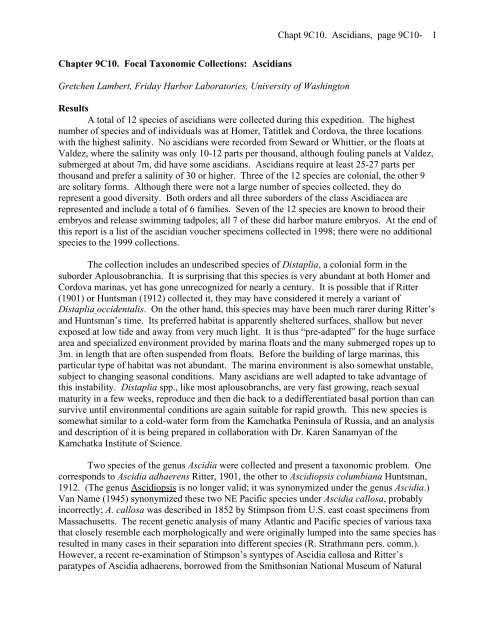Biological Invasions of Cold-Water Coastal Ecosystems - Aquatic ...
Biological Invasions of Cold-Water Coastal Ecosystems - Aquatic ...
Biological Invasions of Cold-Water Coastal Ecosystems - Aquatic ...
Create successful ePaper yourself
Turn your PDF publications into a flip-book with our unique Google optimized e-Paper software.
Chapt 9C10. Ascidians, page 9C10- 1<br />
Chapter 9C10. Focal Taxonomic Collections: Ascidians<br />
Gretchen Lambert, Friday Harbor Laboratories, University <strong>of</strong> Washington<br />
Results<br />
A total <strong>of</strong> 12 species <strong>of</strong> ascidians were collected during this expedition. The highest<br />
number <strong>of</strong> species and <strong>of</strong> individuals was at Homer, Tatitlek and Cordova, the three locations<br />
with the highest salinity. No ascidians were recorded from Seward or Whittier, or the floats at<br />
Valdez, where the salinity was only 10-12 parts per thousand, although fouling panels at Valdez,<br />
submerged at about 7m, did have some ascidians. Ascidians require at least 25-27 parts per<br />
thousand and prefer a salinity <strong>of</strong> 30 or higher. Three <strong>of</strong> the 12 species are colonial, the other 9<br />
are solitary forms. Although there were not a large number <strong>of</strong> species collected, they do<br />
represent a good diversity. Both orders and all three suborders <strong>of</strong> the class Ascidiacea are<br />
represented and include a total <strong>of</strong> 6 families. Seven <strong>of</strong> the 12 species are known to brood their<br />
embryos and release swimming tadpoles; all 7 <strong>of</strong> these did harbor mature embryos. At the end <strong>of</strong><br />
this report is a list <strong>of</strong> the ascidian voucher specimens collected in 1998; there were no additional<br />
species to the 1999 collections.<br />
The collection includes an undescribed species <strong>of</strong> Distaplia, a colonial form in the<br />
suborder Aplousobranchia. It is surprising that this species is very abundant at both Homer and<br />
Cordova marinas, yet has gone unrecognized for nearly a century. It is possible that if Ritter<br />
(1901) or Huntsman (1912) collected it, they may have considered it merely a variant <strong>of</strong><br />
Distaplia occidentalis. On the other hand, this species may have been much rarer during Ritter’s<br />
and Huntsman’s time. Its preferred habitat is apparently sheltered surfaces, shallow but never<br />
exposed at low tide and away from very much light. It is thus “pre-adapted” for the huge surface<br />
area and specialized environment provided by marina floats and the many submerged ropes up to<br />
3m. in length that are <strong>of</strong>ten suspended from floats. Before the building <strong>of</strong> large marinas, this<br />
particular type <strong>of</strong> habitat was not abundant. The marina environment is also somewhat unstable,<br />
subject to changing seasonal conditions. Many ascidians are well adapted to take advantage <strong>of</strong><br />
this instability. Distaplia spp., like most aplousobranchs, are very fast growing, reach sexual<br />
maturity in a few weeks, reproduce and then die back to a dedifferentiated basal portion than can<br />
survive until environmental conditions are again suitable for rapid growth. This new species is<br />
somewhat similar to a cold-water form from the Kamchatka Peninsula <strong>of</strong> Russia, and an analysis<br />
and description <strong>of</strong> it is being prepared in collaboration with Dr. Karen Sanamyan <strong>of</strong> the<br />
Kamchatka Institute <strong>of</strong> Science.<br />
Two species <strong>of</strong> the genus Ascidia were collected and present a taxonomic problem. One<br />
corresponds to Ascidia adhaerens Ritter, 1901, the other to Ascidiopsis columbiana Huntsman,<br />
1912. (The genus Ascidiopsis is no longer valid; it was synonymized under the genus Ascidia.)<br />
Van Name (1945) synonymized these two NE Pacific species under Ascidia callosa, probably<br />
incorrectly; A. callosa was described in 1852 by Stimpson from U.S. east coast specimens from<br />
Massachusetts. The recent genetic analysis <strong>of</strong> many Atlantic and Pacific species <strong>of</strong> various taxa<br />
that closely resemble each morphologically and were originally lumped into the same species has<br />
resulted in many cases in their separation into different species (R. Strathmann pers. comm.).<br />
However, a recent re-examination <strong>of</strong> Stimpson’s syntypes <strong>of</strong> Ascidia callosa and Ritter’s<br />
paratypes <strong>of</strong> Ascidia adhaerens, borrowed from the Smithsonian National Museum <strong>of</strong> Natural














